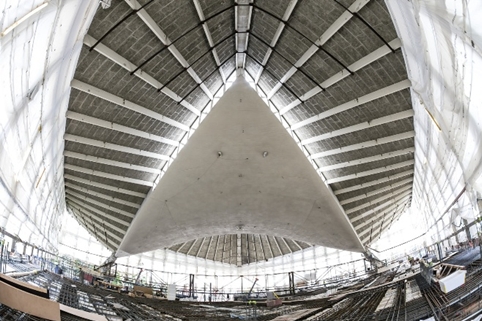A vision for the future – the world’s biggest design museum and design on prime-time TV
This week I visited the site of the Design Museum’s future home in Holland Park, west London.

Source: Miles Willis © 2014 Getty Images
The hyperbolic paraboloid roof at the Design Museum’s new home
The 1962 Commonwealth Building, which will act as the museum’s new home, is still a massive construction site, with contractor Mace working to bring the structure up-to-date before the design team, led by architect John Pawson and with Morag Myerscough working on exhibition design, is handed the keys next year before a 2016 public opening.
The Commonwealth Building is vast – particularly so in its current state, without internal walls. The basement space alone feels equal in size to the Design Museum’s current Shad Thames home. The top level has a beguiling mix of a huge floorplan (560m2) and intimacy provided by the spectacular swooping roof, which traverses the floor from top to bottom.
The Design Museum staff I toured the site with were understandably excited about what the new space could offer them (storage room! Huge airy offices! A free-to-access permanent collection!)
It’s equally exciting to think about not just what the move could mean for the Design Museum, but what it could mean for design’s profile in the UK.
Video:
Visualisation of the new Design Museum foyer
There’s a current lack of high-profile, public facing design institutions in the UK. The Design Museum would be the first to admit that its current venue is inadequate. The Design Council’s Piccadilly Circus Design Centre, which closed in 1998, is still much-mourned.
With its move to Kensington, the Design Museum has an opportunity – and space – to represent contemporary design to the public as well as potentially act as a centre for the design industry.
It will have three exhibition strands – the permanent collection, an alternating selection of “annual” exhibitions such as Designs of the Year”, and a huge space for temporary and touring shows. It will have a library, an auditorium and a learning centre.
The Design Museum is not the only institution with big plans. London’s Kemistry Gallery, which is threatened with closure due to redevelopment of its existing site, has launched an appeal to reform as a bigger and better gallery space – it wants to be the UK’s first major not-for-profit gallery devoted to the visual arts.
Alongside the current lack of high-profile venues, there’s also a current under-representation of design on television. As the Royal College of Art’s Jeremy Myerson told us last week “TV programmes on design usually leave me crimson with embarrassment and rage. They are either unbelievably trite and superficial or stupefyingly dull and boring”.
Video:
Work by Malika Favre, as shown at Kemistry gallery
But think how telegenic the Design Musuem’s build project at Kensington would be? Some of the UK’s leading designers and architects restoring and revitalising one of the country’s most interesting buildings.
And once those TV producers are interested, maybe it’s worth mentioning Designs of the Year? If the Man Booker Prize or the Stirling Prize for architecture can be televised, then why not the stories of projects like the Gov.uk redesign or One Laptop per Child?
Conceivably by 2016 the UK could have not just one of the world’s biggest design museums, but also one of its biggest visual arts gallery and a prime-time TV show devoted to design. Just imagine what that would do for its public profile.
-
Post a comment




